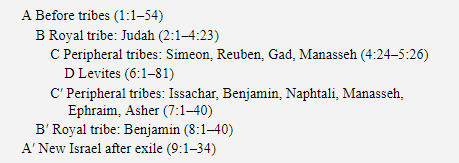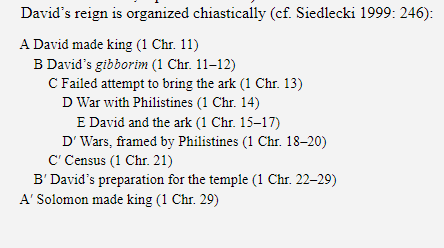RamistThomist
Puritanboard Clerk
Leithart, Peter. 1 & 2 Chronicles. Brazos.
Although I am quite critical of much of Leithart’s project, I do concede that his handling of the biblical text--when he stays at the level of the text--is usually quite good. If you want perceptive outlines of books of the Bible, you could do much worse than Leithart.
1-2 Chronicles echoes the creation account. Leithart suggests the Chronicler “is retelling the entire history of the Old Testament in, with, and under the history of kings.” He proposes the following pattern:
* The genealogies in 1 Chr. 1-9 echoes Genesis
* Saul’s death in 1 Chr. 10 echoes Slavery in Egypt.
* David in 10-29 is Exodus and Sinai
* Solomon in 2 Chr. 1-9 is Joshua’s conquest
* The divided kingdom in 2 Chr. 10-35 is the period of Judges, ending with Saul.
* The decree of Cyrus in ch. 36 is the establishment of the monarchy.
Another main theme is music. “Chronicles tells us who sings when and why.” Leithart suggests that music is a form of “guarding” (1 Chr. 25:8; the term for duties, mishmeret, is derived from shamar, guard).

Key idea: Biblical genealogies lean eschatologically, not protologically.
By beginning with Adam, the Chronicler is telling us that Yahweh is forming a new humanity. David is the Royal Moses. Regarding David's wars, Leithart observes that the geography here contains a “four-cornered theme.” This would suggest the rule of a future Davidic king. He further notes that the Old Testament land is symbolic of the whole world. Section D of the chiasm gives the point for David’s wars: they mediate Yahweh’s justice.

Yahweh’s acts of dividing the people mimics the earlier act of creation. Israel is first divided (badal) from the peoples as Yahweh’s own. Within Israel the Levites are divided from other tribes. Priests are divided from the Levites (Numb. 16:9). They create holiness boundaries, pronouncing clean and unclean.
David and the Levitical Worship
David actually innovates. In 1 Chr. 23:30-32 he includes song within the Levitical order. He further organizes them into mishmeret, watches (1 Chr. 25:8).
Key idea: by including musicians in the center of genealogies, the Chronicler identifies music as the key vocation of man.
A problem with David’s wars and bloodshed. Even just, wars contaminate the land (a large scale application of Num. 19). The first creation is by Yahweh’s Word. The second creation is by the Moses’s conformity to the tabnit on the mountain. The tabnit of New Creation is imprinted on David’s heart and then passed to Solomon
Key idea: Manasseh is alienating himself from Yahweh’s hosts, whether angelic or human army--Yahweh’s human army, if Israel is seen as the earthly sacrament.
Why did Josiah go out to attack Egypt? Leithart, following Pratt (2006), suggests that Josiah might have been a functioning vassal of either Assyria or Babylon. Leithart suggests a deeper, more theological problem. Judah’s kings are vessels of Yahweh’s kingship. They are not supposed to meddle with the kings of other nations. Neco, ironically, is a Gentile ruler much like Sheba and Cyrus. He acts on behalf of Yahweh.
Despite advertising itself as a theological commentary, the book is usually sensitive to the nuances of the Hebrew text. To be sure, we don’t have any reconstructions of the textual history, but no one would read that, anyway. I read this book in one day.
Although I am quite critical of much of Leithart’s project, I do concede that his handling of the biblical text--when he stays at the level of the text--is usually quite good. If you want perceptive outlines of books of the Bible, you could do much worse than Leithart.
1-2 Chronicles echoes the creation account. Leithart suggests the Chronicler “is retelling the entire history of the Old Testament in, with, and under the history of kings.” He proposes the following pattern:
* The genealogies in 1 Chr. 1-9 echoes Genesis
* Saul’s death in 1 Chr. 10 echoes Slavery in Egypt.
* David in 10-29 is Exodus and Sinai
* Solomon in 2 Chr. 1-9 is Joshua’s conquest
* The divided kingdom in 2 Chr. 10-35 is the period of Judges, ending with Saul.
* The decree of Cyrus in ch. 36 is the establishment of the monarchy.
Another main theme is music. “Chronicles tells us who sings when and why.” Leithart suggests that music is a form of “guarding” (1 Chr. 25:8; the term for duties, mishmeret, is derived from shamar, guard).
Key idea: Biblical genealogies lean eschatologically, not protologically.
By beginning with Adam, the Chronicler is telling us that Yahweh is forming a new humanity. David is the Royal Moses. Regarding David's wars, Leithart observes that the geography here contains a “four-cornered theme.” This would suggest the rule of a future Davidic king. He further notes that the Old Testament land is symbolic of the whole world. Section D of the chiasm gives the point for David’s wars: they mediate Yahweh’s justice.
Yahweh’s acts of dividing the people mimics the earlier act of creation. Israel is first divided (badal) from the peoples as Yahweh’s own. Within Israel the Levites are divided from other tribes. Priests are divided from the Levites (Numb. 16:9). They create holiness boundaries, pronouncing clean and unclean.
David and the Levitical Worship
David actually innovates. In 1 Chr. 23:30-32 he includes song within the Levitical order. He further organizes them into mishmeret, watches (1 Chr. 25:8).
Key idea: by including musicians in the center of genealogies, the Chronicler identifies music as the key vocation of man.
A problem with David’s wars and bloodshed. Even just, wars contaminate the land (a large scale application of Num. 19). The first creation is by Yahweh’s Word. The second creation is by the Moses’s conformity to the tabnit on the mountain. The tabnit of New Creation is imprinted on David’s heart and then passed to Solomon
Key idea: Manasseh is alienating himself from Yahweh’s hosts, whether angelic or human army--Yahweh’s human army, if Israel is seen as the earthly sacrament.
Why did Josiah go out to attack Egypt? Leithart, following Pratt (2006), suggests that Josiah might have been a functioning vassal of either Assyria or Babylon. Leithart suggests a deeper, more theological problem. Judah’s kings are vessels of Yahweh’s kingship. They are not supposed to meddle with the kings of other nations. Neco, ironically, is a Gentile ruler much like Sheba and Cyrus. He acts on behalf of Yahweh.
Despite advertising itself as a theological commentary, the book is usually sensitive to the nuances of the Hebrew text. To be sure, we don’t have any reconstructions of the textual history, but no one would read that, anyway. I read this book in one day.
